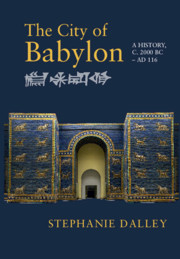Book contents
- The City of Babylon
- The City of Babylon
- Copyright page
- Contents
- Illustrations and Maps
- Preface
- Conventions
- Timeline
- Written Languages and Their Scripts
- 1 Land and Peoples
- 2 Discoveries and Excavations
- 3 First Kings to the End of the Great Rebellion, c. 1894–c. 1732
- 4 Law, Education, Literature, and the Path to Supremacy
- 5 From the Great Rebellion to the End of the First Dynasty, c. 1732–1592
- 6 The Next Six Centuries
- 7 In the Shadow of Assyria, 978–625
- 8 Empire
- 9 From the Death of Nebuchadnezzar II to the Death of Cambyses, 561–522
- 10 Darius I to Alexander, and Seleucid to Parthian Rule
- 11 First Parthian Conquest, 141 BC, to the Visit of Trajan in AD 116
- Appendix: Genesis 14:1–16 and Possible Links with Foreign Rulers Early in the Reign of Hammurabi
- Bibliography
- Index
9 - From the Death of Nebuchadnezzar II to the Death of Cambyses, 561–522
Published online by Cambridge University Press: 23 June 2021
- The City of Babylon
- The City of Babylon
- Copyright page
- Contents
- Illustrations and Maps
- Preface
- Conventions
- Timeline
- Written Languages and Their Scripts
- 1 Land and Peoples
- 2 Discoveries and Excavations
- 3 First Kings to the End of the Great Rebellion, c. 1894–c. 1732
- 4 Law, Education, Literature, and the Path to Supremacy
- 5 From the Great Rebellion to the End of the First Dynasty, c. 1732–1592
- 6 The Next Six Centuries
- 7 In the Shadow of Assyria, 978–625
- 8 Empire
- 9 From the Death of Nebuchadnezzar II to the Death of Cambyses, 561–522
- 10 Darius I to Alexander, and Seleucid to Parthian Rule
- 11 First Parthian Conquest, 141 BC, to the Visit of Trajan in AD 116
- Appendix: Genesis 14:1–16 and Possible Links with Foreign Rulers Early in the Reign of Hammurabi
- Bibliography
- Index
Summary
Following unsuccessful attempts to keep the descendants of Nebuchadnezzar II on the throne, the usurper Nabonidus became king. Persian tribes had moved into Elamite lands, and the Medes made Harran a dangerous city; Nabonidus‘ mother, an aged acolyte of Ashurbanipal, resided there. His lengthy inscriptions are informative about his deeds and his character. He dedicated his daughter to the Moon-god at Ur according to precedent, and spent ten years in Arabia, leaving his son Belshazzar in charge in Babylon. He returned and restored the temple in Harran. Cyrus the Great brought his rule to an end, but continued to employ some high officials. Cyrus was probably of mixed Elamite and Persian descent. The Cyrus Cylinder, inscribed in Babylonian cuneiform for a Babylonian audience, used traditional denigration of the previous king Nabonidus, and acknowledged Marduk as Babylon’s god. In another cuneiform text, Nabonidus was mocked for his scholarly pretensions and for sacrilegious acts. Babylon continued to be the centre where all subsequent kings felt obliged to celebrate the New Year festival to be accepted as legitimate rulers. Old monuments were not defaced. Cyrus may have been responsible for an imitation of Babylon’s glazed bricks at Persepolis. He made his son Cambyses co-regent.
Keywords
- Type
- Chapter
- Information
- The City of BabylonA History, c. 2000 BC – AD 116, pp. 248 - 274Publisher: Cambridge University PressPrint publication year: 2021

